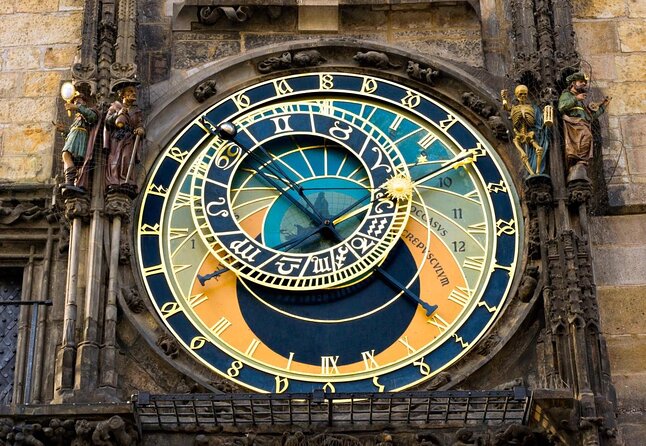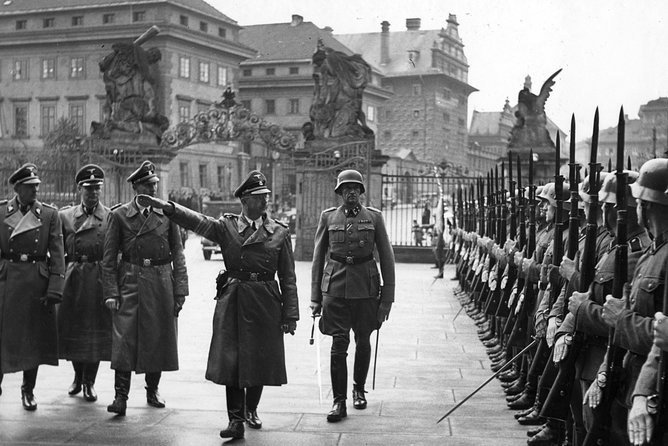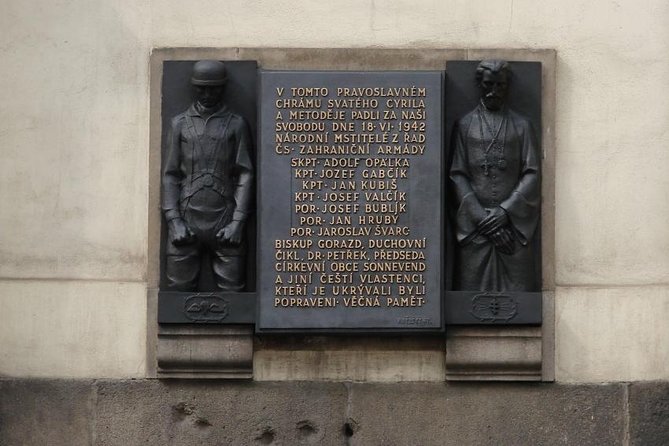The Protectorate of Bohemia and Moravia was a complex and conflicted chapter in Czech history. Established by the Nazis in 1939, it functioned as a client state under German control, severely restricting Czech autonomy. Though governed by Reichsprotektors, the Protectorate became a critical source of manpower and resources for the Nazi war effort. Yet, amidst the brutal repression and cultural suppression, the Czech population displayed remarkable resilience through acts of resistance, preserving their unique identity which continues to shape the national consciousness today. Understanding this intricate history provides invaluable insights into the impact of occupation on a nation’s spirit.
Key Points

- The Protectorate of Bohemia and Moravia was a client state of Nazi Germany established in 1939 after the German occupation of Czech lands.
- The Protectorate was governed by Reichsprotectors appointed by Adolf Hitler and served as a source of manpower and resources for the Nazi war effort.
- The Protectorate experienced brutal repression, with Gestapo and SS atrocities, but the local population staged acts of defiance and resistance against the Nazi authorities.
- The Protectorate maintained a unique social and cultural identity, with a rich heritage of historic architecture and a vibrant arts scene, despite political subordination.
- The legacy of the Protectorate is marked by the perseverance of the Czech people and the scars of Nazi occupation, which serve as a reminder of the dangers of authoritarianism.
Historical Overview of the Protectorate

The Protectorate of Bohemia and Moravia emerged in 1939 after Nazi Germany’s occupation of the Czech lands during World War II. It was established as a client state and a protectorate under German administration, with the Czech government retaining some autonomy.
The Protectorate was ruled by Reichsprotektors appointed by Adolf Hitler, and it served as a source of manpower and resources for the Nazi war effort. Despite its limited autonomy, the Protectorate retained some aspects of Czech culture and identity.
However, the Protectorate was also the site of brutal repression, with the Gestapo and SS carrying out numerous atrocities against the Czech population. The legacy of the Protectorate remains a complex and contested chapter in Czech history.
You can also read our reviews of more tours and experiences in Prague.
Geographic Location and Borders

The Protectorate of Bohemia and Moravia encompassed the historical lands of Bohemia and Moravia, located in central Europe. It bordered Germany to the west and northwest, and the Protectorate of Slovakia to the southeast.
The territory of the Protectorate included:
-
Bohemia, covering an area of 52,065 square kilometers.
-
Moravia, covering an area of 22,623 square kilometers.
-
Silesia, covering an area of 5,153 square kilometers.
Together, these regions formed a significant part of the former Czechoslovakia, with Prague serving as the capital city of the Protectorate.
The geographic position and boundaries of the Protectorate played a crucial role in its historical development and political significance during the tumultuous period of World War II.
Political Structure and Governance
Under the political structure of the Protectorate of Bohemia and Moravia, the Reichsprotector (Imperial Protector) governed the territory on behalf of Nazi Germany. This position was initially held by Konstantin von Neurath, who oversaw the administrative and political affairs of the Protectorate.
The Reichsprotector had significant authority, including the power to issue decrees and laws. However, the Protectorate maintained a degree of autonomy, with its own government and institutions, although they were ultimately subordinate to the Reich.
The Protectorate’s National Assembly, led by Emil Hácha, had limited legislative powers but served as a facade of self-governance. The Protectorate’s political structure was characterized by German control and the suppression of Czech independence.
Economic Conditions and Development
During the Protectorate’s existence, Nazi Germany exerted significant control over the economic affairs of Bohemia and Moravia, transforming the region into an integral part of the Reich’s wartime economy.
Key aspects of the economic landscape during this period include:
-
Centralized industrial production: The Nazis consolidated and streamlined industrial operations, prioritizing the manufacturing of war materials and goods to support the German war effort.
-
Exploitative labor practices: The Protectorate’s workforce was subjected to harsh conditions, with the Nazis leveraging both local and imported labor to maximize production.
-
Severe restrictions on trade and commerce: The Nazis imposed strict controls on trade, limiting the region’s economic autonomy and integrating it into the broader German economic system.
Social and Cultural Significance
Despite the Protectorate’s political and economic subordination to Nazi Germany, Bohemia and Moravia maintained a unique social and cultural identity during this period.
The region’s rich heritage, including its historic architecture, vibrant arts scene, and deep-rooted traditions, continued to thrive.
While the Protectorate was subject to German influence, local communities fiercely guarded their cultural autonomy.
Bohemian and Moravian people took pride in their language, customs, and way of life, resisting attempts at germanization.
This cultural resilience helped preserve the distinct character of the Protectorate, even as it faced the challenges of wartime occupation.
The social and cultural significance of Bohemia and Moravia endured, serving as a source of strength and identity for the local population.
Resistance and Persecution
The Protectorate’s population fiercely resisted the Nazi occupation, staging acts of defiance and sabotage against the German authorities. Tragically, this resistance was met with severe persecution, as the Nazis cracked down on any dissent or challenges to their rule.
Among the forms of resistance were:
-
Clandestine radio broadcasts that rallied the public and shared news the Nazis tried to suppress.
-
Students and intellectuals organizing anti-Nazi demonstrations and boycotts.
-
Underground groups like the Czech Resistance conducting guerilla attacks and sabotage against German military and infrastructure.
The Nazis responded with mass arrests, torture, deportations to concentration camps, and public executions in a brutal effort to crush the Protectorate’s defiant spirit.
Legacy and Impact
Ultimately, the legacy of the Protectorate of Bohemia and Moravia remains a complex and contentious topic, marked by both the perseverance of the Czech people in the face of oppression and the lasting scars of the Nazi occupation.
The bold resistance movements and covert operations that undermined the Protectorate’s puppet government are a source of national pride, but they also came at a heavy price in terms of lives lost and freedoms curtailed.
Today, the history of the Protectorate serves as a grim reminder of the dangers of authoritarianism and the importance of defending democratic ideals.
As the Czech Republic has emerged as a stable, prosperous European democracy, its past struggles under Nazi rule continue to shape its national identity and commitment to human rights.
Visiting Historical Sites
Today, visitors can explore the historical sites and monuments that bear witness to the complex legacy of the Protectorate of Bohemia and Moravia.
One of the most significant locations is the Memorial in the crypt of the Church of St. Cyril and St. Methodius, where visitors can pay respects to the heroic soldiers who sacrificed their lives in the resistance against the Nazi occupation.
Plus, the tour includes stops at:
-
Wenceslas Square, the iconic Prague landmark where the Czech resistance movement held demonstrations.
-
The former headquarters of the Gestapo, a sobering reminder of the oppression faced by the Czech people.
-
The Memorial to the Victims of Communism, honoring those who suffered under the subsequent totalitarian regime.
Frequently Asked Questions
What Is the Duration of the Guided Tour?
The guided tour’s duration is not specified in the knowledge provided. The overview covers the tour’s location, operator, meeting and end points, inclusions, and additional details, but does not mention the tour’s length.
Are Any Photo Stops or Breaks Included in the Tour?
The tour doesn’t mention any specific photo stops or breaks. However, the moderate physical fitness level required suggests there may be opportunities to take photos and rest during the tour, though this isn’t explicitly stated in the details provided.
Can the Tour Be Customized or Personalized?
The tour operator doesn’t advertise any options to customize or personalize the tour. The standard itinerary and inclusions are fixed, so there’s limited flexibility to tailor the experience to individual preferences.
Is the Tour Available in Languages Other Than English?
The tour is available in multiple languages, including English. Customers can inquire about language options when booking the tour. The operator, Inna Poljakova, provides guided services in the desired language to ensure a personalized experience.
What Is the Cancellation and Refund Policy for the Tour?
The tour’s cancellation and refund policy isn’t specified in the overview. Customers should check with the operator, Inna Poljakova, for details on any cancellation fees or refund eligibility prior to booking the tour.
Recap
The Protectorate of Bohemia and Moravia was a tragic chapter in Czech history.
Though harshly suppressed by the Nazis, the Czech people displayed remarkable resilience, preserving their unique identity and heritage.
The Protectorate’s legacy continues to shape the national consciousness, serving as a poignant reminder of the importance of self-determination and the enduring spirit of a people in the face of oppression.
More Tour Reviews in Prague
Not for you? Here's more things to do in Prague we have recnetly reviewed
- 7 Best Canoe And Kayak Experiences In Prague
- 16 Best Christmas Experiences In Prague
- 25 Best Cruises And Boat Tours In Prague
- 25 Best Dining Experiences In Prague
- 25 Best Food Tours In Prague
- 16 Best Full-Day Tours In Prague
- 4 Best 2 Day Tours In Prague
- 2 Best Coffee Tours And Tastings In Prague
- 15 Best Massage And Relaxation Services In Prague
- 20 Best Photography Experiences In Prague
- 13 Best Craft Beer Tours And Tastings In Prague
- 25 Best Dinner Tours In Prague
